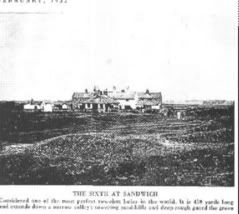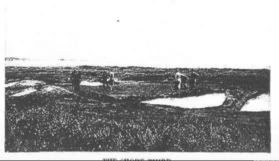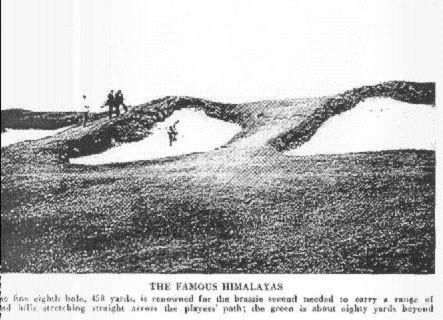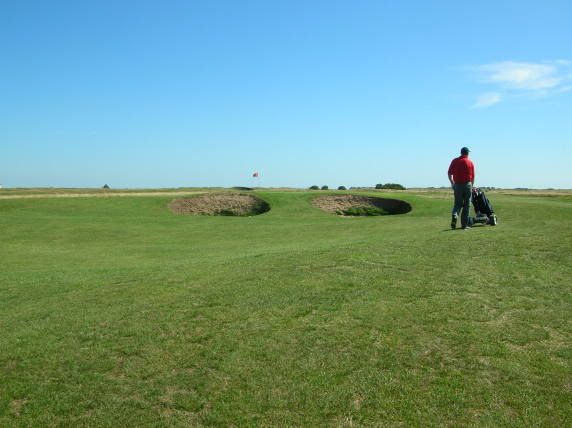I’ve made the illustrations of the course above larger so hopefully those who’ve played the modern Prince’s can get a feel for where the old course ran. I’ve come across a second route map for the old course in an old encyclopaedia and it is essentially the same as the above one. I’ve also added a few more distances to the above table as they appear in the following excerpts from Golf Illustrated. The modern pictures were taken last year and based on the report that 17 of the green sites were reused, I thought they might help give a flavour of some of the holes- even if they are clearly not the same today.
It appears to me that Prince’s might even have existed in 3 forms. The original idea was to have a course which could be played by ladies – but that is hardly appropriate to the post WW1 Course described below. Interestingly the post WW2 course was again supposed to be friendly to women.
Bob found an article via the USGA archives website from Golf Illustrated by George W Greenwood Feb 1932 pgs 10 & 11. It was written a year before the Open was played there.

Some more excerpts:-
Prince’s ..may properly be described as one of the world’s great courses. It is pre-eminent, because of many factors, among them length, situation and character, the later being the most outstanding. Prince’s positively shouts its individuality from every tee and green. No two holes are alike...
In the Great War these same desolate dunes were a vast network of trenches, hidden gun emplacements and barbed wire entanglements...
Obviously Prince’s is essentially a tiger’s course
The distinctive feature of Prince’s is the number of dog-legged... holes with diagonal cross bunkers at strategic points.
I have heard Hagen and Bobby Jones say that on a day of wind there is no finer, and no more skilful test of golf to be found...It is golf in excelcis...
The short third has become famous because of its many difficulties, and the fiendish manner in which it is guarded. A long narrow green is virtually enclosed by bunkers, a dozen in all..

One of the most perfect two-shot holes is the 6th which runs along a narrow valley...Towering sand-hills on the right, and a ridge and deep rough on the left...


(club website todays 9th SHORE)
Known as the Himalayas the 8th is renowned because of the second shot with a brassie which has to carry a range of sand hills straight in the player’s path. Eighty yards or so on the other side is the green.

The tee shot here is then followed by a second over the dunes on the right of the picture over...

The same range of sand hills confronts the player at the dog legged 11th, but this time is concerns the drive. The mighty hitters aim a far as they dare to the left, in order to make the second shot to the green, nestling in hummocky ground at the foot of the hills, less of a gamble. It was at this hole that Cyril Toley hit what is, perhaps, one of the most colossal drives ever seen. Taking the narrow but dangerous line, he carried the hills at a point 270 yards or more from the tee..
The 15th has been selected by Miss Joyce Wethered as a typical drive and iron hole for her ideal course. The green is set on a plateau with a cross- bunker in its near face. The pin is about 15 yards beyond and a highly skilful shot of the backspin type ahs to be played if the ball is to be stooped.

Two magnificent wooden club shots must be struck if the green at the seventeenth (539 yards) is to be reached, in deed the number of times on which the feat has been accomplished cane be counted on the fingers of the two hands.
MacKenzie wrote in the Spirit of St Andrews (1934).
Princes is very long and difficult. The one-shot holes, although far from easy, have not the charm one has aright to expect on such a magnificent golfing ground. There are some good do-legged holes, but too many of a similar type- that is , a drive over a line of sand hills running diagonally away fro the players.
The Royal St. Georges Courses at Sandwich has amore variety and, although not so difficult, has a more lasting appeal than Princes.
Robert Hunter. The Links (1926)
At Prince’s and at St. Georges one plays in and out of great swales lying across huge dunes, and now and then one is forced to cross the dunes.
On another page he says his visit to Prince’s was in 1912.
I don’t have the relevant books by Darwin and Hutchinson but I’d love to know what they had to say about the course.
Definitely a top ten contender for the next list “Greatest NLE’s”.